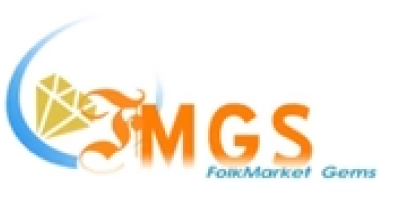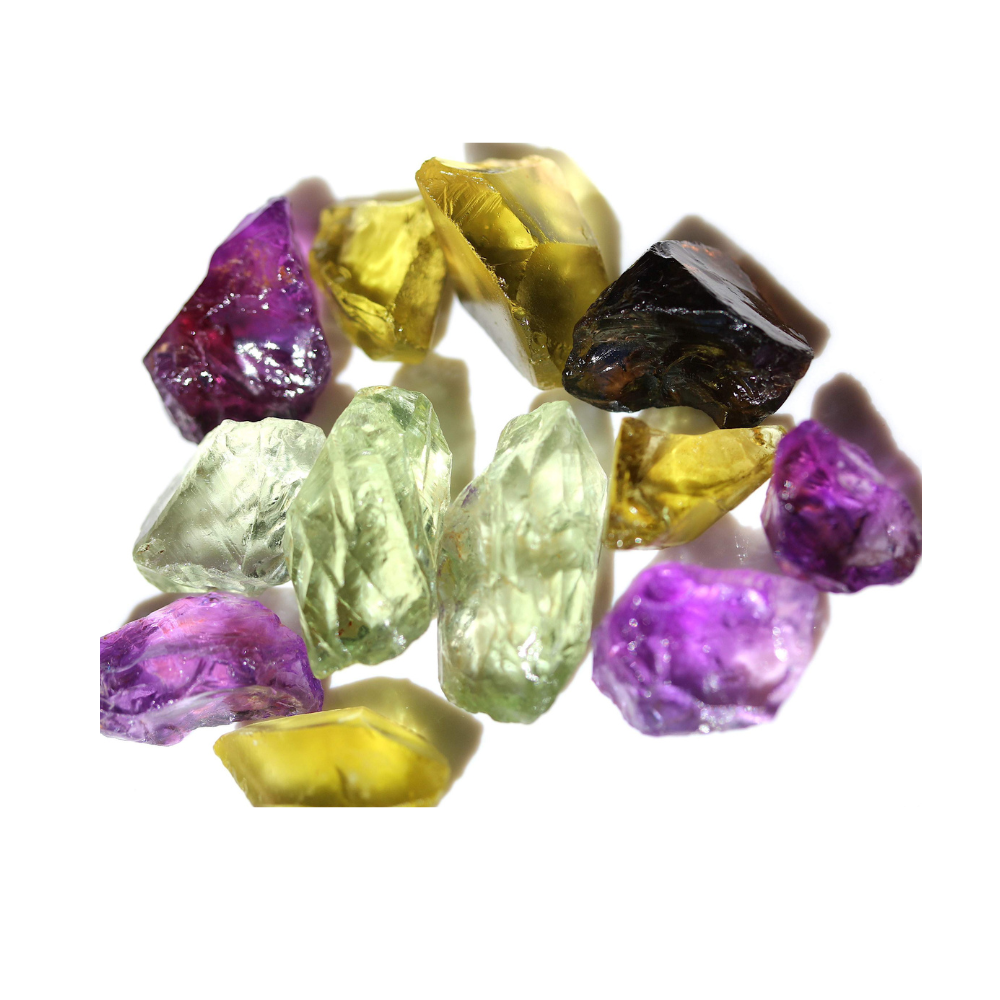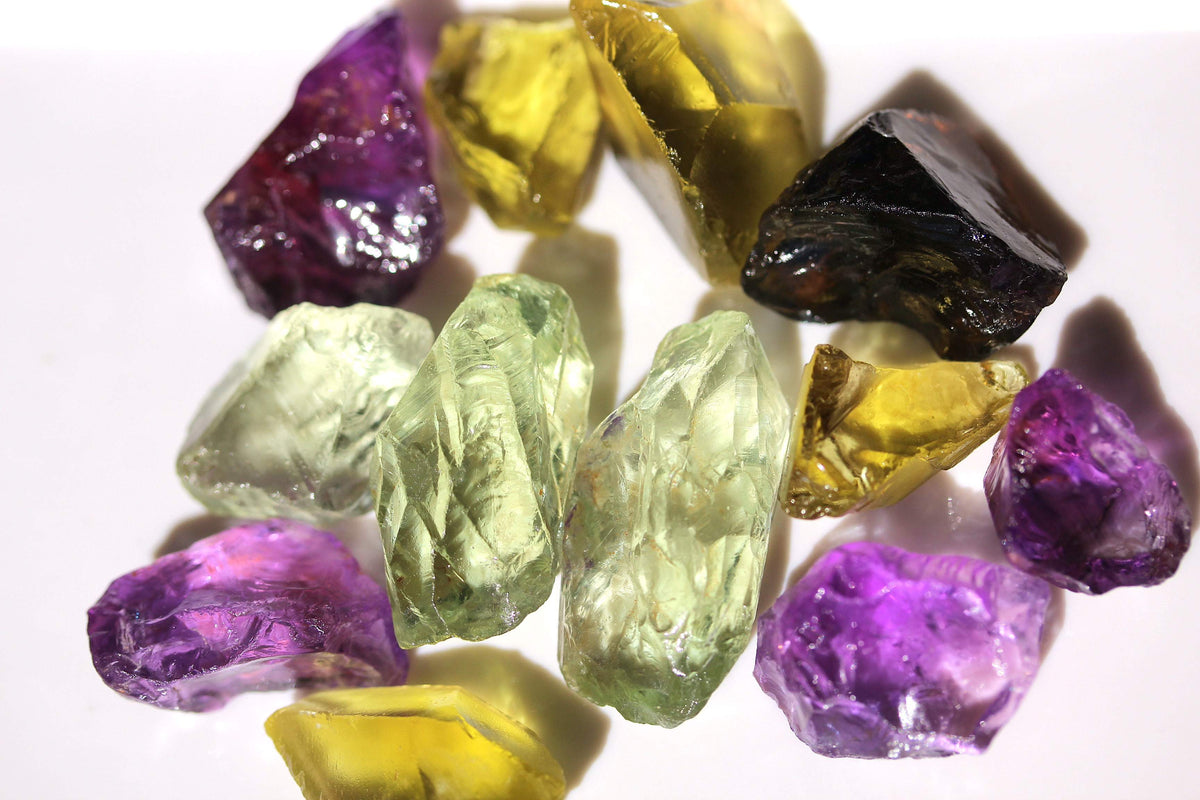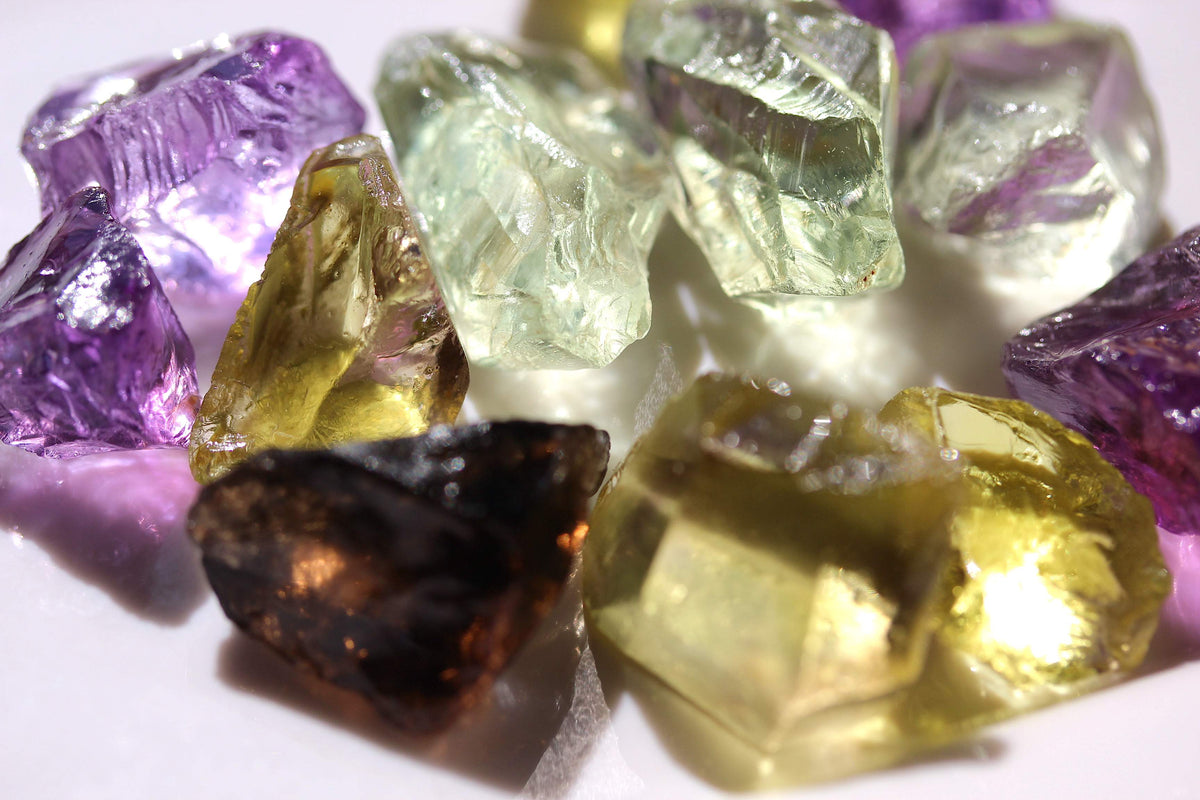
Understanding Facet Rough and Cabochon Grade Lapidary Rough: A Guide for Gem Cutters
Explore the Difference Between Facet Rough and Lapidary Rough
Gemstones have attracted the humans for centuries. Gemstones sparkle, shine, and come in many colors and shapes. You might come across terms like "facet rough" and "lapidary rough" while exploring natural and 100% natural gemstones in raw form. These terms are important if you want to cut, shape, or sell gemstones. In this article, we will explain the difference between facet rough and lapidary rough to help you make informed decisions when selecting raw stones for cutting. Understanding what you're cutting is crucial. We'll compare the two types of raw stones in terms of quality, characteristics, and price. This guide will also assist you in identifying gemstone quality.
What is Facet Rough? How to Define Facet Grade Gemstones?
Facet rough is a piece of gemstone material that is suitable for faceting. Faceting is a process where the gem is cut into flat surfaces called facets. These facets are arranged in a precise pattern. When done correctly, faceting makes the gemstone sparkle and reflect light beautifully.

Facet grade rough gemstones needs to be of gem quality. It must be free from cracks, inclusions and important thing is that it should be transparent to the maximum . Inclusion means tiny particles and imperfection inside the gems. These flaws can ruin the final appearance of any gemstone. Common gemstones that can be faceted, they are included diamonds, sapphires, emeralds, and rubies.These facet cut gemstones can enhance the beauty of any jewelry because of their radiant colors and sparkling quality. Opaque stones are also faceted some times however, transparent stones are ideal for faceting. After cutting, such raw stones will be called " faceted stones " after faceting.
Main points about facet grade uncut Gemstones
1- Quality in Raw Form of Facet grade gemstones:
A facet rough stone is a natural, uncut gemstone. It has not been processed or polished and appears as it does when mined from the earth. The natural crystals should be clean and free of inclusions such as smoke, tiny particles, or other minerals. If we cut stones with these inclusions, the result will be unattractive and of low value. Facet rough stones without such inclusions have beautiful clarity and sparkle. Faceting these clean stones enhances their beauty and worth.

2- Potential for Faceting:
All rough stones are not suitable for faceting. It must have some specific qualities that the stone should possess such as color, clarity, less inclusions, transparency, size and shapes. Having all these qualities in a collector crystal type, still a collector crystal or mineral specimen would not be cut or faceted. Rather they will be kept for collectors or geologists analysis or for museum. Therefor what particular qualities should be for selecitng a facet rough stone? Here are listed below:-
- Clarity: The rough stone must consist of minimal inclusions (internal flaws). The inclusions obstruct the path of light through the facets of the stone. THis prevents the brilliance while stopping light reflection effectively. This is the reflection which gives brilliance to the stone. Without clear light passage to travel and bounce back from the facets, the stone would look opaque. The stone brilliance will be diminished significantly.
- Shape: The shape of rough stone should allow the gemstone cutters for the cutting of facets without losing excessive weight. Shape also defines that the stone should be faceted or kept for collection. For example, if a stone has nice hexagonal and rare shapes, they are selected for collections. Though the stone will have nice clarity, shape and size.
- Fractures: The stones should not have any internal or external fractures because it will break the stone while faceting them
- Color: Color comes at the last, because even light colors can be faceted if they have good clarity and less inclusions.
- Size: The rough should be large enough to allow for cutting and shaping into a faceted gem of a significant size
3- Transparency:
- Inclusions: Facet rough gemstones should be free from cracks , inclusions and should be clean. In natural gemstones there come some kind of impurities and tiny elements inside the gems. A facet grade rough stones is free from such imperfections.
- Specific Shape: They are often found in shapes that are easily to cut into facets.
- Used for Sparkling Gems: It is used to make gemstones that sparkle and reflect light.
4- Faceting Process:
Faceting involves cutting the rough gemstone into a specific geometric pattern to maximize its brilliance and sparkle. This is done using precise angles and carefully placed flat surfaces called facets.
The process is detailed and requires skill to ensure that the facets are cut at the correct angles to enhance the stone’s optical properties, such as light reflection and refraction.
Characteristics of Facet Rough Gems:
- Features that make a stone suitable for faceting (e.g., high clarity, brilliance).
- Examples of typical stones cut as facets
Cutting Process for Faceted Gems:
- Steps involved in faceting.
- Tools and techniques used.
Uses and Applications:
- Popular uses are used in gemstones jewelry
What is Lapidary Rough Or Cabochon Grade Raw Stone?
Lapidary rough are raw gemstone material used for various types of cutting and shaping. Lapidary is the art of working with stones to create beautiful crafts. Lapidary rough can be used for cabochons, carvings, beads, and other decorative items. Lapidary rough gemstones are also called cabochon grade gemstones.

Like facet rough, lapidary rough does not need to be perfect. It can have inclusions and cracks. These flaws can sometimes add to the character of the final piece. Many different types of stones can be used as lapidary rough, including agate, jasper, turquoise , quartz and many others.
Differences Between Facet Rough and Lapidary Uncut Gemstones
We have checked out about what facet rough and lapidary rough are. Let's look also at the key differences between them.
- Quality
Facet rough are always of very high quality. Any flaw can affect the light reflection and overall beauty of the faceted gem. Lapidary rough does not need to be perfect. Inclusions and cracks can enhance the beauty of the final piece sometimes.
- Use
Facet rough is specific used to make faceted gems. These gems are set in jewelry like rings, necklaces, and earrings. The luster, clarity and sparkling enhance the beauty of that jewelry. Lapidary rough is used for a different range of items. It can be cut into cabochons, carvings shapes, beads, and other decorative items.
- Cutting Process
The process of cutting facet rough is always precise and technical. The right angle facet cut always ensure the sparkling of gem. This requires skill and experience of faceting artist. Cutting of lapidary rough can be less precise. The cutting master often have more freedom to shape the stone in creative ways.
Examples of Facet Rough
- Diamond: Diamonds are the most famous faceted gemstones. They are cut into many shapes like round, princess, and emerald cuts.
- Sapphire: Sapphires are faceted to enhance their deep blue color and sparkling. They are popular in rings and other jewelry.
- Emerald: Emeralds are famous for its rich green color. Good faceting make them shine and display their natural beauty.
Examples of Lapidary Rough
- Agate: Agate is used to make cabochons and beads. Agate has interesting patterns and colors. They are cut into beads, cabochons, and for many other decorative pieces of art.
- Jasper: Jasper is popular for carvings and decorative items. It comes in many colors and patterns.
- Turquoise: Turquoise is commonly used for making beads and cabochons. It is prized for its beautiful blue-green color.
- Lapislazulli: Lapis is an opaque stone and popular for using in lapidary work. Different types of cabochons, tumbles, beads are created from Lapis.

Result Comparison of Cut Gemstones after Cutting Facet Grade and Cabochon Grade
Examples of Facet Rough Stones after cutting:
Facet grade raw stones are cut into faceted stones in different shapes such as oval, pear, round, emerald and many others. The will look as following aftter cutting

Comparison of Facet Rough Before and After Cutting

Examples of Cabbing Grade Rough or Lapidary Rough Stones after cutting:
As lapidary rough stones are used into creating cabochons, tumbles, beads, carving or any creating any other sculptures. Here are examples of cut stones that how they will look after lapidary work.

Comparison of Facet Rough Before and After Cutting

Price Difference Between Facet Rough and Lapidary Rough
The price difference between facet rough and lapidary rough due to quality, use, and rarity of the materials. Let's explore more in details about the factors that contribute to their price.
Main Factors Affecting the Price of Facet Rough
- Quality: Facet rough must be of high quality. The absence of any inclusions and cracks makes facet rough more expensive. High-quality facet grade uncut stones are very rare and always demand a higher price.
- Type of Gemstone: The gemstone type also affects the price. Diamonds, sapphires, emeralds, and rubies are among the most expensive facet rough materials because of their popularity and demand.
- Size: Larger pieces of facet rough are more expensive. They can be cut into larger faceted gems, which are more valuable.
- Color and Clarity: The color and clarity of the gemstone play a vital role in pricing. Vivid colors and high clarity increase the value of facet rough gemstones.
- Market Demand: The market demand for such gemstones can influence their price. For example, rare and popular gemstones like diamonds and emeralds often have higher prices.
- Treatment: The natural form of gemstones always has high value. Untreated and unheated facet grade uncut gemstones always sell at good price because of its 100% originality.
Main Factors that may affect the Price of Lapidary Rough
- Type of Stone: The type of stone significantly affects the price. Common stones like agate and jasper are generally less expensive than rarer stones like high-quality turquoise or opal.
- Size and Shape: Larger pieces of lapidary rough can be more expensive. Especially if they are suitable for large carvings or multiple pieces of jewelry.
- Patterns and Colors: Unique patterns and vibrant colors can increase the value of lapidary rough. Stones with interesting patterns are often sought after by artists and jewelers. For examples for examples trapiche sapphires and emerald, star sapphires and rubies have high value in demand.
- Quality: Although lapidary rough can have inclusions and imperfections. High-quality pieces like Australian opals, star sapphires, and many other rare gemstones without major flaws are still more valuable.
- Artistic Potential: Some lapidary rough stones are priced higher because of their potential for creating unique and beautiful items. Such stones that inspire artistic designs can demand higher prices.
Price Comparison Examples
Facet Rough
- Diamond Facet Rough: High-quality diamond rough can cost thousands of dollars per carat. Prices differ greatly depending on size, color, and clarity. For example, a high-quality 1-carat diamond facet rough may have cost around $2,000 to $5,000.
- Sapphire Facet Rough: High-quality sapphire rough can range from $50 to $500 per carat, depending on color and clarity. Vivid blue sapphires are particularly valuable.
- Emerald Facet Rough: Emerald rough prices can range from $100 to $1,000 per carat. High-quality, deep green emerald rough is especially expensive.
Lapidary Rough
- Agate Lapidary Rough: Agate is relatively inexpensive. Prices can range from $1 to $10 per pound, depending on the quality and patterns.
- Jasper Lapidary Rough: Jasper is also affordable, with prices ranging from $2 to $20 per pound. Unique patterns and colors can increase the price.
- Turquoise Lapidary Rough: Turquoise prices vary widely. High-quality turquoise rough can cost between $50 to $200 per pound, depending on color and matrix patterns.
Summary of Price Differences
- Facet Rough: Generally more expensive due to the high quality and precise cutting required. Prices are determined by gemstone type, size, color, clarity, and market demand.
- Lapidary Rough: Typically less expensive than facet rough. Prices depend on the type of stone, size, shape, patterns, colors, and artistic potential.
The price difference between facet rough and lapidary rough is influenced by various factors, including quality, type of gemstone, size, color, clarity, and market demand. Facet rough is usually more expensive because it needs to be high quality and is used to create sparkling, faceted gems. Lapidary rough, while often less expensive, offers a wide range of possibilities for creative and artistic expressions in gemstones. Understanding these price differences can help collectors, jewelers, and enthusiasts make informed decisions when purchasing rough gemstones.
How Gemstone Cutters' See the Difference Between the Both Type?

Conclusion
Understanding the difference between facet rough and lapidary rough is important if you are interested in gemstones. Facet rough is high-quality material used for faceting, making gems that sparkle and shine. Lapidary rough is used for a variety of purposes, including making cabochons, carvings, and beads. It can have imperfections that add to its character. Both types of rough play crucial roles in the world of gemstones, each contributing to the beauty and artistry of this fascinating field.
By knowing these differences, you can better appreciate the skills and artistry involved in creating beautiful gemstone pieces. Whether you are a collector, a jeweler, or simply a gemstone enthusiast, understanding these terms will enhance your appreciation of these natural wonders.
Learn also Related Articles
- What are popular stones for beginners to start faceting?
- Learn about Cleavage in Stone before cutting a gemstone?
- What are main processes of faceting a stone?
- What are three types of gemstone cutting Shapes?
- What is Luster in Gemstones?










